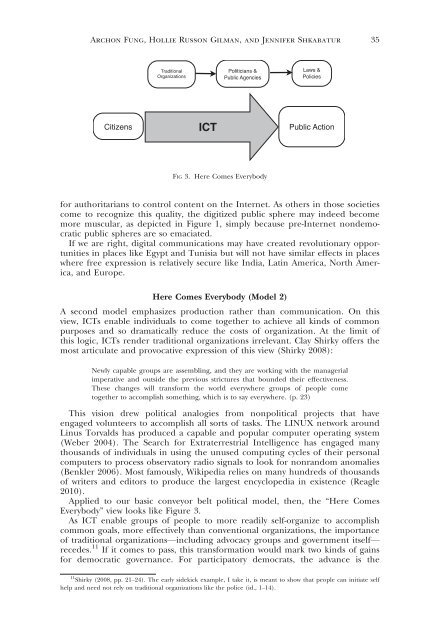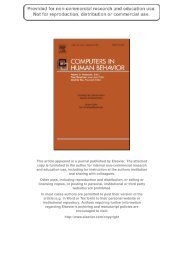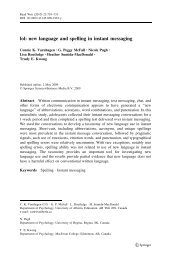Six Models for the Internet + Politics
Create successful ePaper yourself
Turn your PDF publications into a flip-book with our unique Google optimized e-Paper software.
Archon Fung, Hollie Russon Gilman, and Jennifer Shkabatur 35<br />
FIG 3. Here Comes Everybody<br />
<strong>for</strong> authoritarians to control content on <strong>the</strong> <strong>Internet</strong>. As o<strong>the</strong>rs in those societies<br />
come to recognize this quality, <strong>the</strong> digitized public sphere may indeed become<br />
more muscular, as depicted in Figure 1, simply because pre-<strong>Internet</strong> nondemocratic<br />
public spheres are so emaciated.<br />
If we are right, digital communications may have created revolutionary opportunities<br />
in places like Egypt and Tunisia but will not have similar effects in places<br />
where free expression is relatively secure like India, Latin America, North America,<br />
and Europe.<br />
Here Comes Everybody (Model 2)<br />
A second model emphasizes production ra<strong>the</strong>r than communication. On this<br />
view, ICTs enable individuals to come toge<strong>the</strong>r to achieve all kinds of common<br />
purposes and so dramatically reduce <strong>the</strong> costs of organization. At <strong>the</strong> limit of<br />
this logic, ICTs render traditional organizations irrelevant. Clay Shirky offers <strong>the</strong><br />
most articulate and provocative expression of this view (Shirky 2008):<br />
Newly capable groups are assembling, and <strong>the</strong>y are working with <strong>the</strong> managerial<br />
imperative and outside <strong>the</strong> previous strictures that bounded <strong>the</strong>ir effectiveness.<br />
These changes will trans<strong>for</strong>m <strong>the</strong> world everywhere groups of people come<br />
toge<strong>the</strong>r to accomplish something, which is to say everywhere. (p. 23)<br />
This vision drew political analogies from nonpolitical projects that have<br />
engaged volunteers to accomplish all sorts of tasks. The LINUX network around<br />
Linus Torvalds has produced a capable and popular computer operating system<br />
(Weber 2004). The Search <strong>for</strong> Extraterrestrial Intelligence has engaged many<br />
thousands of individuals in using <strong>the</strong> unused computing cycles of <strong>the</strong>ir personal<br />
computers to process observatory radio signals to look <strong>for</strong> nonrandom anomalies<br />
(Benkler 2006). Most famously, Wikipedia relies on many hundreds of thousands<br />
of writers and editors to produce <strong>the</strong> largest encyclopedia in existence (Reagle<br />
2010).<br />
Applied to our basic conveyor belt political model, <strong>the</strong>n, <strong>the</strong> “Here Comes<br />
Everybody” view looks like Figure 3.<br />
As ICT enable groups of people to more readily self-organize to accomplish<br />
common goals, more effectively than conventional organizations, <strong>the</strong> importance<br />
of traditional organizations—including advocacy groups and government itself—<br />
recedes. 11 If it comes to pass, this trans<strong>for</strong>mation would mark two kinds of gains<br />
<strong>for</strong> democratic governance. For participatory democrats, <strong>the</strong> advance is <strong>the</strong><br />
11 Shirky (2008, pp. 21–24). The early sidekick example, I take it, is meant to show that people can initiate self<br />
help and need not rely on traditional organizations like <strong>the</strong> police (id., 1–14).
















